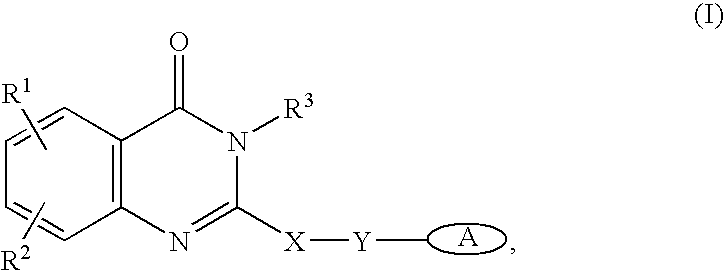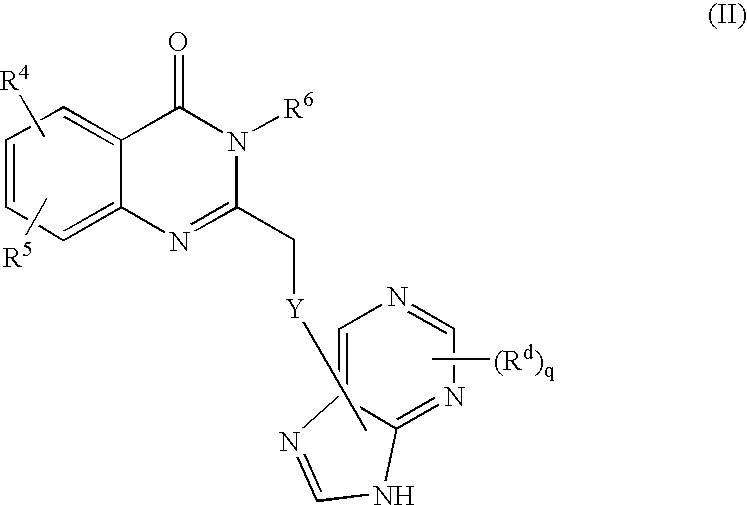Inhibitors of human phosphatidyl-inositol 3-kinase delta
a phosphatidylinositol 3-kinase and inhibitor technology, applied in the field of selective inhibitors of pi3 k activity, can solve the problems of limited utility of these compounds in studying the roles of individual class i pi 3-kinases, lack of knowledge of structural and functional features of pi 3-kinase enzymes, etc., to inhibit growth or proliferation, the effect of inhibiting growth
- Summary
- Abstract
- Description
- Claims
- Application Information
AI Technical Summary
Benefits of technology
Problems solved by technology
Method used
Image
Examples
example 1
Preparation and Purification of Recombinant PI3Kα, β, and δ
[0428]Recombinant PI3K heterodimeric complexes consisting of a p110 catalytic subunit and a p85 regulatory subunit were overexpressed using the BACTO-BAC® HT baculovirus expression system (GIBCO / BRL), and then purified for use in biochemical assays. The four Class I PI 3-kinases were cloned into baculovirus vectors as follows:
[0429]p110δ: A FLAG®-tagged version of human p110δ (SEQ ID NO:1) (see Chantry et al., J Biol Chem, 272:19236-41 (1997)) was subcloned using standard recombinant DNA techniques into the BamH1-Xba1 site of the insect cell expression vector pFastbac HTb (Life Technologies, Gaithersburg, Md.), such that the clone was in frame with the His tag of the vector. The FLAG® system is described in U.S. Pat. Nos. 4,703,004; 4,782,137; 4,851,341; and 5,011,912, and reagents are available from Eastman Kodak Co.
[0430]p110α: Similar to the method used for p110δ, described above, a FLAG®-tagged version of p110α (see Voli...
example 2
PI3Kδ High Throughput Screen (HTS) and Selectivity Assay
[0438]A high throughput screen of a proprietary chemical library was performed to identify candidate inhibitors of PI3Kδ activity. PI3Kδ catalyzes a phosphotransfer from γ-[32P]ATP to PIP2 / PS liposomes at the D3′ position of the PIP2 lipid inositol ring. This reaction is MgCl2 dependent and is quenched in high molarity potassium phosphate buffer pH 8.0 containing 30 mM EDTA. In the screen, this reaction is performed in the presence or absence of library compounds. The reaction products (and all unlabelled products) are transferred to a 96-well, prewetted PVDF filter plate, filtered, and washed in high molarity potassium phosphate. Scintillant is added to the dried wells and the incorporated radioactivity is quantitated.
[0439]The majority of assay operations were performed using a BIOMEK® 1000 robotics workstations (Beckman) and all plates were read using Wallac liquid scintillation plate counter protocols.
[0440]The 3× assay sto...
examples 3-7
[0449]Since PI3Kδ is expressed at significant levels only in leukocytes, it is important to study the effects of the PI3Kδ-selective inhibitor on leukocyte functions. Accordingly, the effects of PI3Kδ inhibition in several types of leukocytes were examined. Neutrophils were examined to determine the effects that selective inhibition of PI3Kδ might elicit (Example 3, below). It surprisingly was found that selective inhibition of PI3Kδ activity appears to be significantly associated with inhibition of some but not all functions characteristic of activated neutrophils. In addition, the effects of PI3Kδ inhibition on B cell and T cell function also were tested (Examples 4-5, below). Moreover, as PI3Kδ also is expressed in osteoclasts, the effect of PI3Kδ inhibition on the function of these specialized cells was studied (Example 6, below).
PUM
| Property | Measurement | Unit |
|---|---|---|
| Fraction | aaaaa | aaaaa |
| Fraction | aaaaa | aaaaa |
| Fraction | aaaaa | aaaaa |
Abstract
Description
Claims
Application Information
 Login to View More
Login to View More - R&D
- Intellectual Property
- Life Sciences
- Materials
- Tech Scout
- Unparalleled Data Quality
- Higher Quality Content
- 60% Fewer Hallucinations
Browse by: Latest US Patents, China's latest patents, Technical Efficacy Thesaurus, Application Domain, Technology Topic, Popular Technical Reports.
© 2025 PatSnap. All rights reserved.Legal|Privacy policy|Modern Slavery Act Transparency Statement|Sitemap|About US| Contact US: help@patsnap.com



